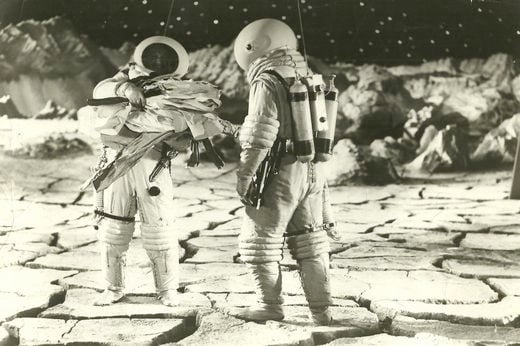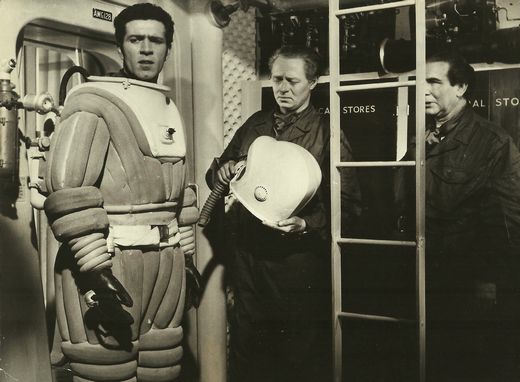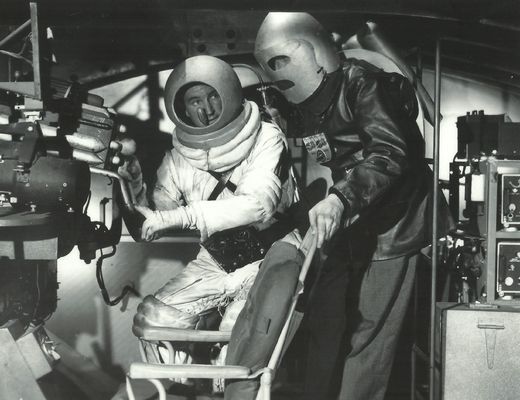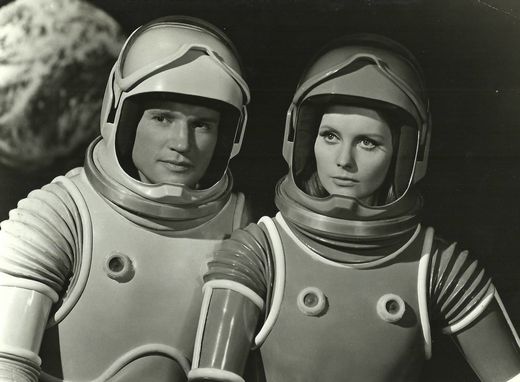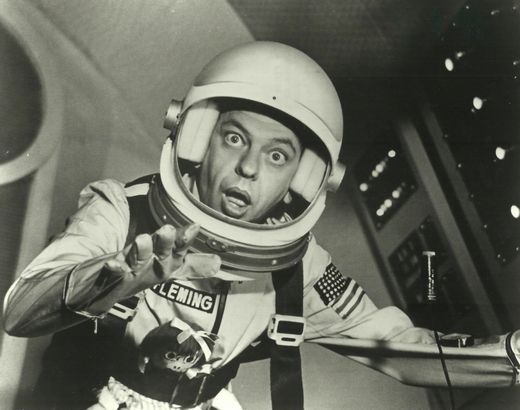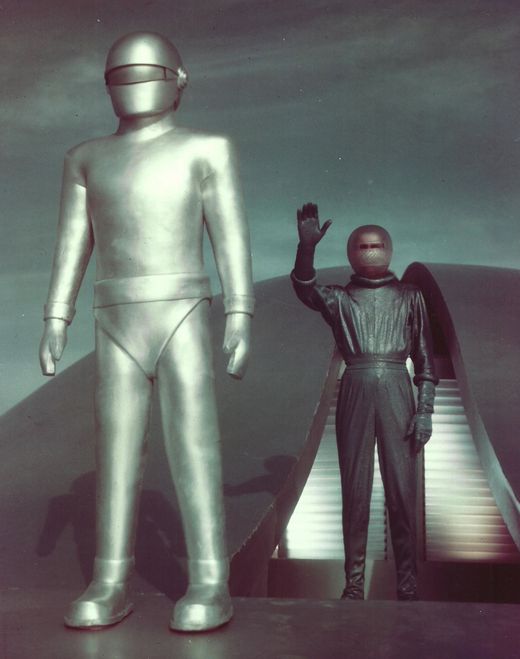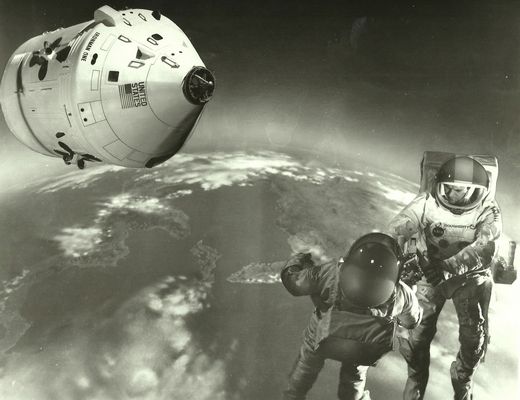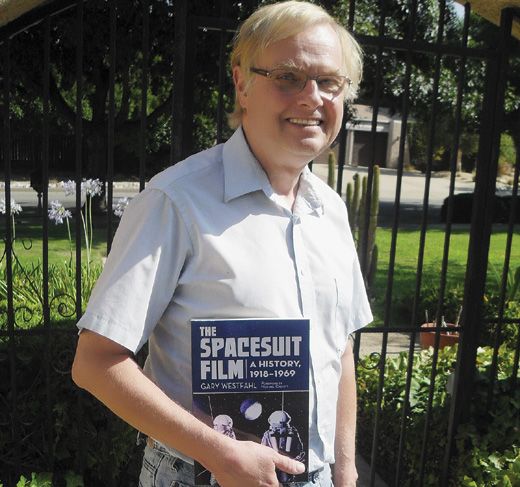Hollywood’s Spacesuits
A sci-fi historian’s guide to movie spacesuits, from wacky to realistic
/https://tf-cmsv2-smithsonianmag-media.s3.amazonaws.com/filer/Westfahl-spacesuits-631.jpg)
Author of the recently published The Spacesuit Film: A History, 1918–1969, Gary Westfahl has written or edited more than 20 books on science fiction. Associate editor Diane Tedeschi chatted with him by email in June.
Air & Space: At what age did your passion for science fiction film develop? Do you remember the first sci fi film that you saw? If yes, what was so memorable about this film?
Westfahl: I probably first became interested in science fiction films around the age of seven, although my parents did not always allow me to see them. Getting science fiction books from the library was far less problematic. As a matter of family lore, the first science fiction films I ever watched were a 1957 triple feature of The Deadly Mantis, The Zombies of Mora Tau, and The Man Who Turned to Stone, but I have no memories of these films. The first science fiction film that really had an impact on me was Space Master X-7 (1958), a poorly made but enthralling film about a woman who picks up a sort of virus from an unmanned space probe that causes her to create a pulsating fungus called “bloodrust” whenever she touches anything. For a while, I was literally terrified by the film, as I would check under the bed and in the closet of every hotel room we entered to make sure that no bloodrust was lurking therein. The larger point the film may have communicated to me, one emphasized in my book, was that outer space is stranger than we imagine, and the things we find there may not conform to human expectations – such as forms of alien life that do not resemble a man in a rubber suit.
In your experience, is there a big overlap between space exploration buffs and sci fi fans?
Most science fiction fans, I believe, are also enthusiastic supporters of the space program. One might note, for example, that former astronaut Story Musgrave will be a Guest of Honor at the next World Science Fiction Convention in Chicago; science fiction writers like Ben Bova, Arthur C. Clarke, and Lee Correy have written nonfiction books advocating new initiatives in space; and every science fiction convention I have attended included a table of people representing groups promoting space travel. I personally confirmed this connection in 2003 when, in the wake of the Columbia disaster, I wrote an online commentary suggesting that science fiction had played a role in unwisely pushing the American space program too far too quickly, when the proper technology was not yet in place, and that it was time to consider a moratorium on human space travel. The immediate responses from the science fiction community were overwhelmingly negative, even vitriolic, so much so that author Michael Cassutt then wrote his own commentary about the controversy, arguing that support for the space program constituted the “third rail” of science fiction, analogous to Social Security in the political arena, something that no one in the science fiction community could safely criticize.
How do you define a “spacesuit film”? And how important are spacesuit films as a sub-genre of science fiction film?
I define a spacesuit film as one which endeavors to portray space travel realistically, and since the constant danger of the vacuum of space means that space travelers will always have to wear spacesuits, or have them handy in case of emergencies, the presence of spacesuits in a space film can serve as one clear indication that the filmmakers understand, and are seeking to convey, the harsh realities of space (although, as my book documents at length, there are also a number of films, which I term pseudo-spacesuit films, that include spacesuits in their otherwise nonsensical stories). How important these films are is a matter of opinion. For me, they constitute the most important kind of science fiction film, since they are endeavoring to construct, even if clumsily, an entirely new sort of narrative to match the entirely new sort of experience that a permanent life in space will necessarily entail. Living in space or on other worlds will be utterly different than living on Earth, in innumerable respects, and we need to recognize this now in order to begin preparing for this revolutionary transformation in human history. Other space films, which dubiously maintain that life in space will be basically similar to life on Earth, and meekly follow conventional narrative patterns like melodrama, comedy, and horror, are by this standard both unadventurous and dangerously fallacious if considered as actual anticipations of the future. For other critics, though, spacesuit films are merely an unimportant and rather dull subcategory of science fiction film, as they prefer the more familiar sort of entertainment offered by “Star Trek” (1966-1969) and similar films and television programs.
What is a classic example of a spacesuit film? And why is this film a good example of the sub-genre?
To me, the film that essentially defined the subgenre was Destination Moon (1950); two earlier films, the German Frau im Mond (Woman in the Moon) (1929) and the Russian Kosmicheskiy Reys (The Space Voyage) (1935), did endeavor to portray space travel in a realistic manner, but Destination Moon was really the first film to fully achieve this goal, and perhaps most importantly, it also inspired a series of other films, including Project Moonbase (1953), Riders to the Stars (1954), Conquest of Space (1955), and the television series Men into Space (1959-1960), with similar priorities. Perhaps the most striking scene in Destination Moon shows three spacesuited astronauts emerging from their spaceship to stand on its surface, upside down from the perspective of viewers, to contemplate the dark immensity of space; to me, this epitomizes the value of such films in showing just how strange and disorienting life in space will really be.
Are there any film spacesuits that are notably realistic?
Since the co-author of Destination Moon, Robert A. Heinlein, had also worked on the development of high-altitude pressure suits during World War II, the spacesuits in that film were particularly impressive, which is why they were reused in several later films. But all of the other films listed above also featured reasonably realistic spacesuits. After the launch of the actual American space program, most films merely imitated NASA’s designs, although the film 2001: A Space Odyssey (1968) did envision a more advanced model for its future space travelers. (Director Stanley Kubrick, however, deliberately had all of his spacesuits destroyed, since he was aware of the fate of the spacesuits from Destination Moon and did not want his own creations to resurface in any lesser films.) One feature of the spacesuits in both of those films – the use of bright colors to identify individual astronauts and make them conspicuous against the monochromatic background of space – has oddly not been employed in constructing actual spacesuits, though it seems to represent an idea worth considering.
Are there any movie spacesuits that depart from reality? Have you seen anything delightfully wackadoodle?
One of the strangest spacesuit designs, oddly enough, was developed by rocket scientist Wernher von Braun and was displayed in an interesting documentary, “Man and the Moon,” which aired as an episode of “Disneyland” in 1955. Von Braun imagined that future astronauts would essentially have to be entombed in a large structure, resembling a top, with a transparent dome to provide a view of one’s surroundings and mechanical arms on all sides to manipulate objects in space. There may have been a certain logic behind his idea, but these contraptions look very bizarre indeed. The semi-pornographic Nude on the Moon (1961) featured some memorably laughable spacesuits, made of a thin skintight fabric that seemed insufficient protection against a cold night in Florida, let alone conditions on the moon; still, they did have leather breastplates and codpieces to provide a semblance of protection. Also, while the astronauts are wearing space helmets and gloves, their bare necks and bare wrists are visible, demonstrating that the spacesuits are spectacularly less than airtight. It was fortunate indeed that the moon these astronauts happened to land on implausibly had a climate resembling Earth’s, because they would have instantly died on the actual moon.
What is your opinion of the Apollo 11 spacesuit film starring Neil Armstrong and Buzz Aldrin? After the long build-up of imagining men walking on the moon, was the reality in this case a bit of a letdown?
Knowing that this landing on the moon was actually occurring, no viewer could reasonably say that the televised images of Armstrong and Aldrin were disappointing, particularly when they were walking about in unusual ways that persuasively conveyed the moon’s lower gravity. Like billions of others, I sat enthralled in front of the television set during their entire sojourn on the moon. It is also interesting to compare their carefully choreographed activities with scenes from fictional space films, which the administrators of NASA were surely familiar with, particularly the lunar landing sequence of Destination Moon, which in some respects eerily anticipated the actual event. Still, it is amusing to note that when the astronauts planted the American flag on the moon, CBS anchorman Walter Cronkite complained that there “ought to be some music” to accompany this event, indicating that the experience, for him, was falling short of the drama of earlier films.
Do you think 2001: A Space Odyssey is a masterpiece?
I do believe, like many others, that 2001: A Space Odyssey is the greatest science fiction film ever made. I especially appreciate the film because it goes about as far as science fiction can go in probing humanity’s future, taking audiences to the point where we come into contact with alien life and start advancing to the next stage of human evolution. As I discuss in my book, the film also presents the unique argument that in order to truly conquer space, humans will have to transform themselves so that they can survive in the vacuum of space (like the Star Child, floating in Earth orbit at the end of the film). Finally, the film wisely says little about the nature of its aliens, and of the advanced human race they create; for attempting to take the story any further – to describe aliens or superhumans in detail – is essentially impossible for human observers, so science fiction works that make the effort merely fall back upon conventional—and very human—characterizations. This becomes particularly clear if one studies, as I have studied, the disappointing sequels to 2001 written by Arthur C. Clarke, which drop the subject of human advancement and gradually transform the film’s enigmatic aliens into blundering idiots.
Do you agree that some sci fi movies are so bad that they are worth watching? What is your opinion of Plan 9 from Outer Space?
In the course of researching this book, I was required to watch an extraordinary number of films that I could logically anticipate would be very bad, so much so that it became my habit to regularly inform my wife, “I have to go watch another bad science fiction film.” As a result, for a long time my wife mistakenly imagined that “bad science fiction films,” not spacesuit films, represented the actual subject of my next book. However, I derive no pleasure from watching such films merely to laugh at the subpar acting, inane stories, risible dialogue, and atrocious special effects; in one article, I likened this to laughing at handicapped people. Thus, I did sit through Plan 9 from Outer Space once, many years ago, but I never want to go through that mind-numbing experience again.
I do, however, cherish some bad science fiction films because they are also interesting films; by all standards of cinematic excellence, for example, Frankenstein Meets the Spacemonster (1965) is every bit as awful as Plan 9 from Outer Space, but it offers a fascinatingly incongruous mixture of narrative patterns from previous space films, and the film does address an important issue, albeit ineptly, the question of whether space travel is best carried out by humans or by machines. Also, most observers regard “The Invisible Enemy” (1964) as one of the very worst episodes of “The Outer Limits,” and I can understand why, because from one perspective it is merely a contrived story about a ludicrous reptilian monster lurking beneath the sands of Mars. However, I discuss that episode at length in The Spacesuit Film because it is focused on another very important issue raised by spaceflight: namely, should missions be controlled by the astronauts on the scene, or by their experienced and well-informed monitors on Earth? The episode presents the argument that the astronauts should be in charge, even though NASA has maintained its policy – incorrectly, in my view – of micromanaging all space missions from the ground.
What are some undiscovered gems among the space science fiction film genre that our readers should consider watching?
In one respect, this is a difficult question, for I fully recognize that the things I find entertaining in space films are not necessarily things that other people will find entertaining. But I will venture a few recommendations. Project Moonbase, co-authored by Robert A. Heinlein, is largely a childish adventure story, but one has to admire a film from 1953 that presents a woman as the commander of the first lunar mission – given that assignment, we ultimately learn, by a female President of the United States; the film also offers some striking scenes of life on a zero-gravity space station, with people walking on the ceiling and sitting on the walls.
Another film from that era is properly derided for the nonsensical idea that motivates its space mission – the theory that meteors all have some mysterious protective coating that scientists need to study in order to make spaceflight possible – but Riders to the Stars merits a second look as the first film that accurately anticipated the collaborative nature of space flight, as its astronauts are constantly in contact with, and depend upon the advice of, capable monitors on the ground, and it also features some of the best acting I have observed in true spacesuit films, most notably Martha Hyer as scientist Jane Flynn.
What advice do you have for people who are interested in writing books and articles about sci fi film?
The policy governing my writing career, whether it involves science fiction literature or science fiction film, has always been the same: to establish the parameters of my research, and then try to study every single work that falls within those parameters. Most studies of science fiction film, I think, are weakened by selectivity: critics devote most of their time to the films that everybody knows are good, and they ignore or neglect the films that everybody knows are awful. But some of my most valuable insights into the nature of the spacesuit film have come from films that other critics have paid no attention to – including, in addition to some films already mentioned, Gog (1954), the Italian Totò nella Luna (Totò in the Moon) (1957), First Man into Space (1959), the Czechoslovakian Baron Prášil (The Fabulous Baron Munchausen) (1961), and Mutiny in Outer Space (1965).
In sum, the last thing the world needs now is yet another analysis of Blade Runner (1982); I would instead encourage researchers to find and watch some science fiction films that almost no one has discussed before, and I strongly suspect that they will find the experience immensely rewarding.
See the photo gallery for more sci-fi movie spacesuits.
